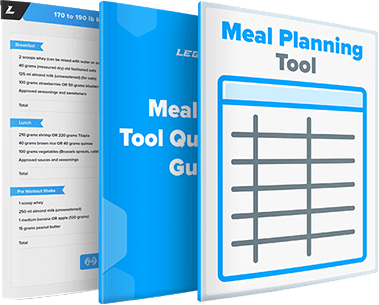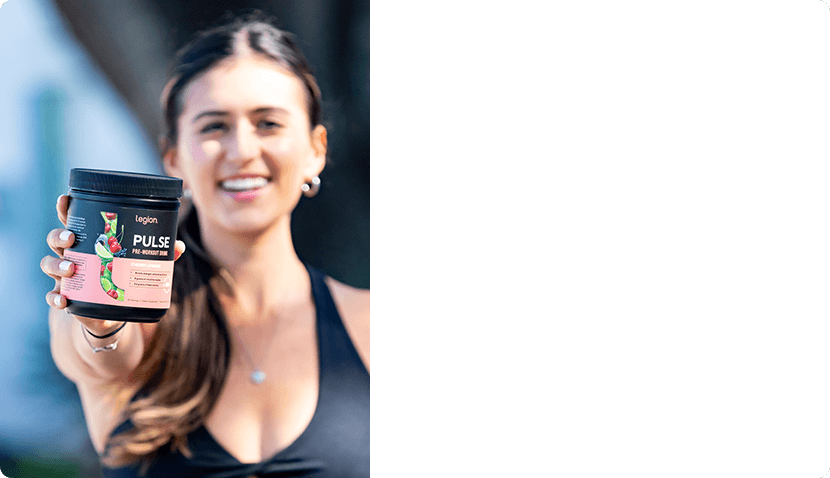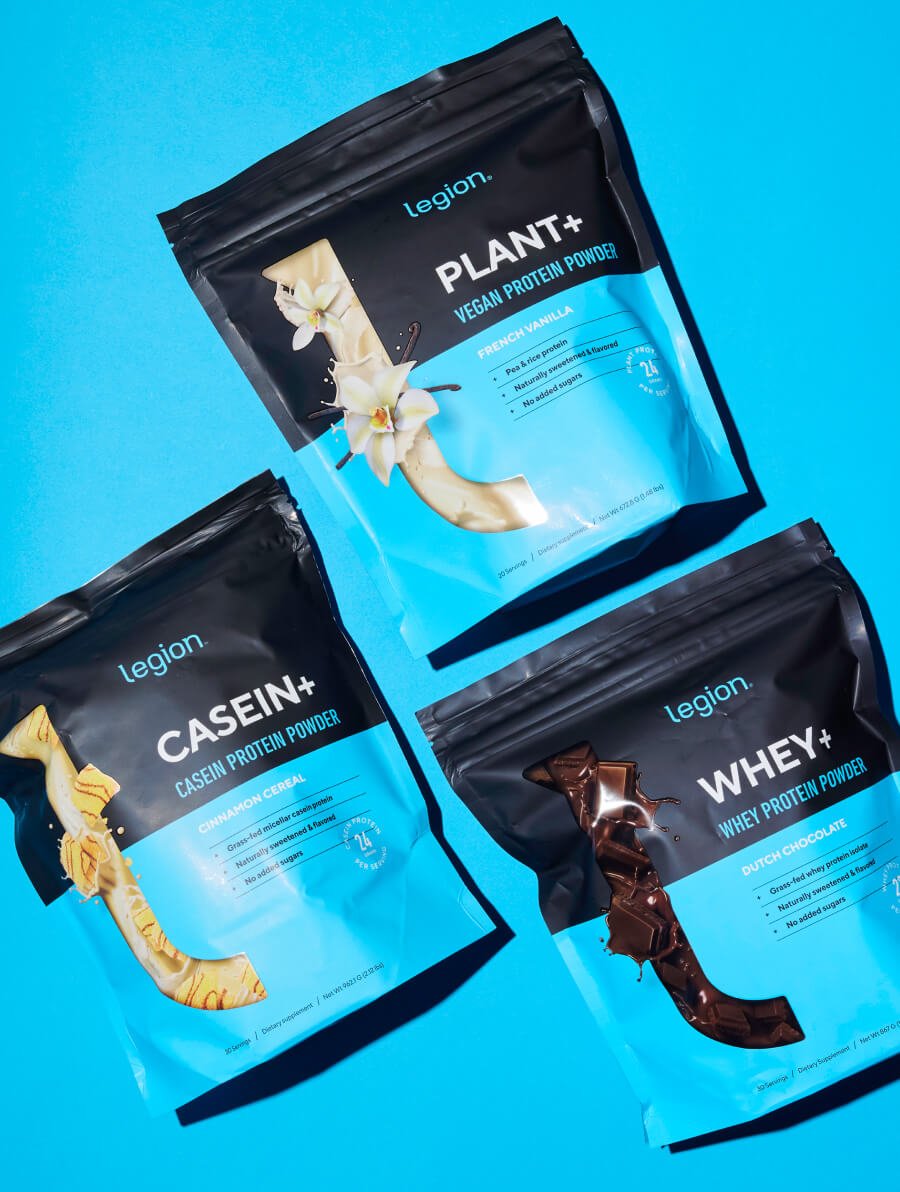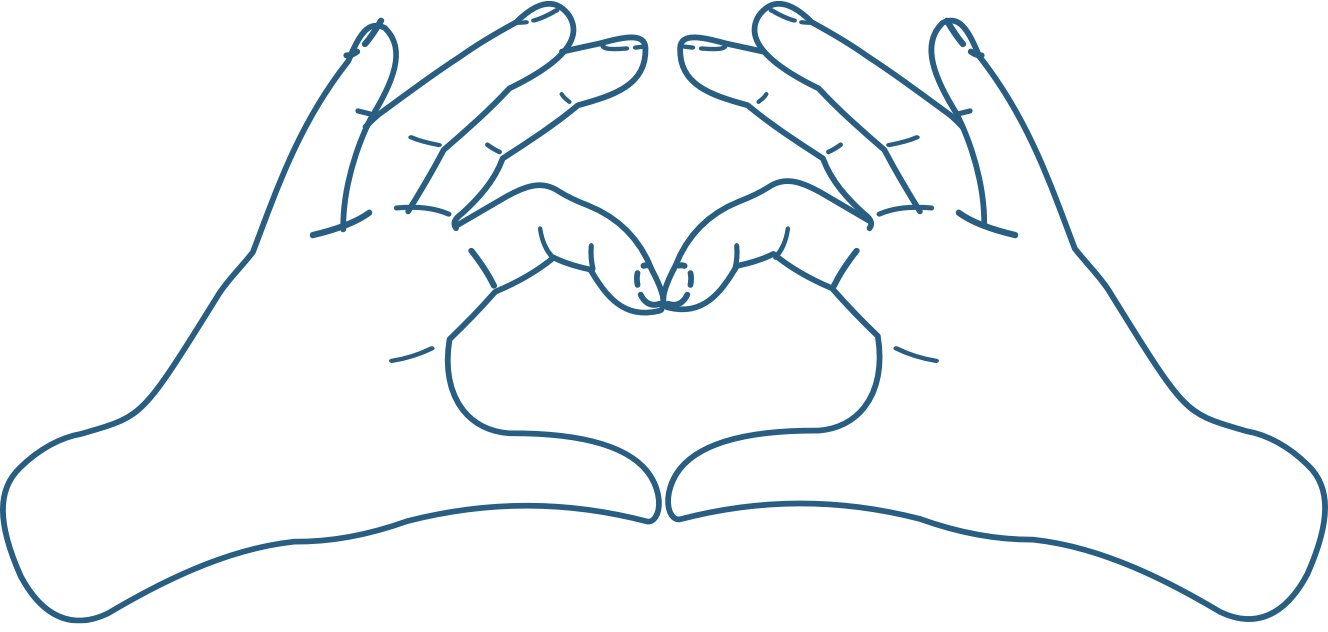Most guides you find online about how to strengthen your hamstrings fall short.
They focus on ineffective hamstring exercises and recommend following second-rate hamstring workouts.
Following this advice will never help you develop big, strong hamstrings.
Instead, you need to do hamstring strengthening exercises that allow you to train through a long range of motion, lift heavy weights safely, and progress regularly.
And that’s precisely what you’ll learn in this article.
Here’s our expert guide to the best hamstring exercise and workout routines for adding serious size to the back of your thighs.
Hamstrings Anatomy
The hamstrings are a group of three leg muscles on the back of your thigh:
- Semitendinosus
- Semimembranosus
- Biceps femoris
Here’s how they look:
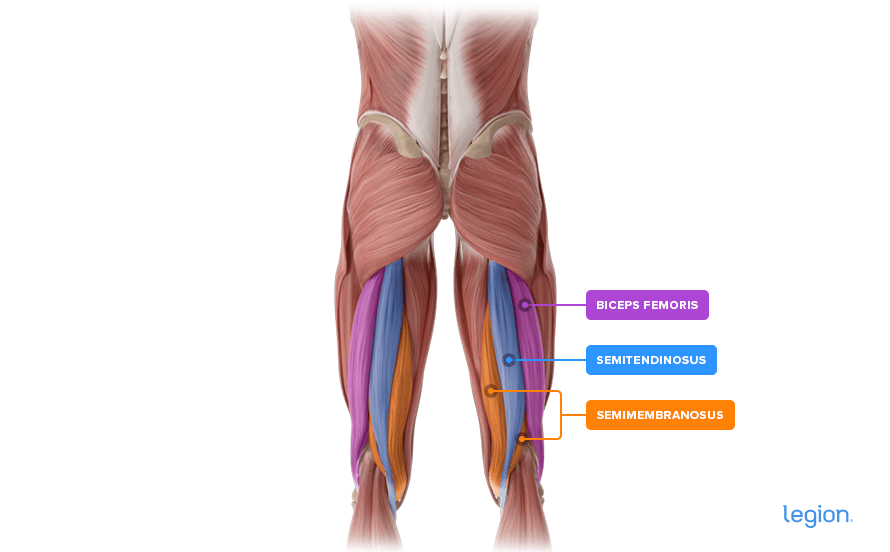
Their main functions are knee flexion (bending the knee) and hip extension (moving your thighs away from your torso).
The 8 Best Exercises for Hamstring Size and Strength
The first step in learning how to grow your hamstrings is determining the best exercises for the back of your thighs.
Below are 8 top-tier hamstring strengthening exercises to include in your hamstring-focused leg days.
1. Deadlift
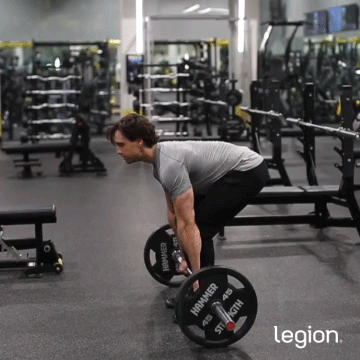
The deadlift trains every muscle on the back of your body, including your hamstrings. It also allows you to lift heavy weight safely and progress regularly, making it ideal for building strong hamstrings. That’s why every good hamstring-focused leg day involves deadlifting.
- Position your feet slightly narrower than shoulder-width apart with your toes pointed slightly out.
- Move a loaded barbell over your midfoot so it’s about an inch from your shins.
- Grip the bar just outside your shins with your palms facing you.
- Flatten your back and drive your body upward and slightly back by pushing through your heels until you’re standing up straight.
- Reverse the movement and return to the starting position.
2. Romanian Deadlift
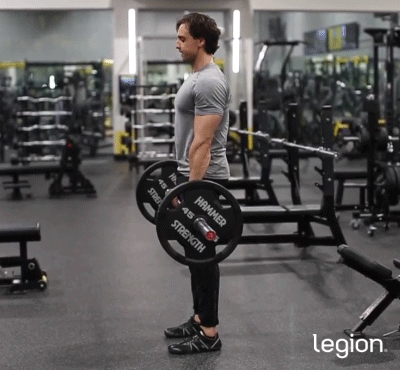
The Romanian deadlift is one of the best hamstring exercises for mass because it trains many of the same muscles as the regular deadlift but causes far less fatigue, so you can do it more often without wearing yourself to a frazzle.
- Stand with your feet hip-width apart and holding a loaded barbell with a shoulder-width grip and your palms facing toward you.
- Flatten your back and lower the weights toward the floor in a straight line while keeping your legs mostly straight, allowing your butt to move backward as you descend.
- Once you feel a stretch in your hamstrings, bend your knee joints slightly more, and continue lowering the weights until your lower back begins to round.
- Reverse the movement and return to the starting position.
3. Single-Leg Romanian Deadlift
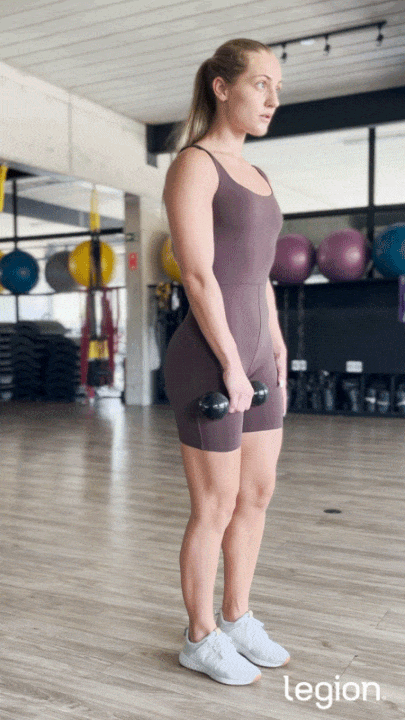
The single-leg Romanian deadlift is a fantastic dumbbell hamstring exercise. It works well as part of any hamstring-focused leg day because it helps you establish a stronger “mind-muscle connection” with your hamstrings by focusing on one side of your body at a time, which may enhance muscle growth in some scenarios.
- Stand up straight and hold a dumbbell in your right hand in front of your right thigh.
- Flatten your back and lower the weight toward the floor in a straight line while keeping your right leg mostly straight, allowing your butt to move backward and your left leg to straighten behind you as you descend.
- Once your right hamstring stretches, bend your right knee slightly more, and continue lowering the weight until your lower back begins to round.
- Reverse the movement and return to the starting position.
- Repeat the process on the left side once you’ve completed the desired number of reps.
4. Good Morning
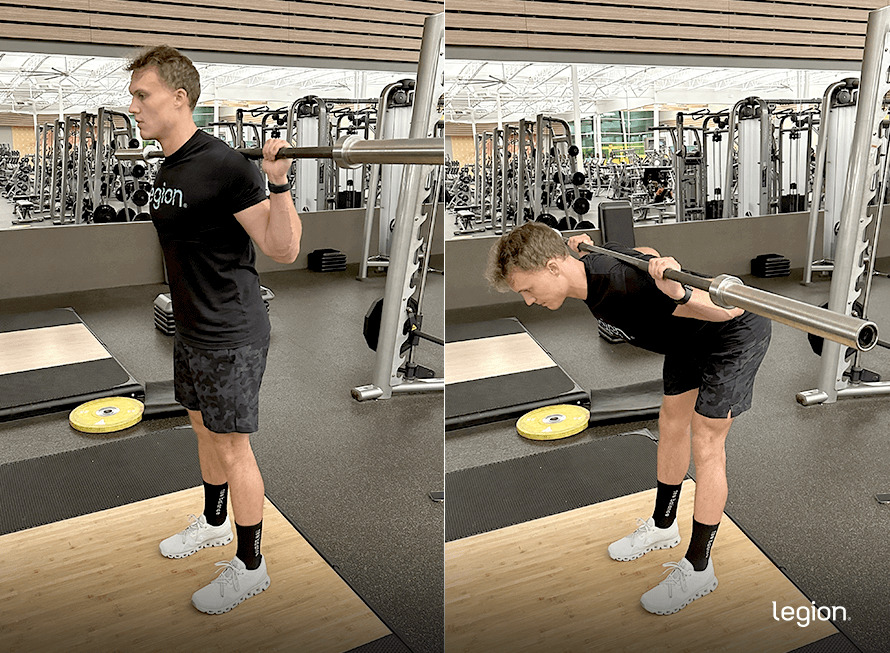
The good morning is another solid barbell hamstring exercise because it allows you to train your hamstrings and glutes with heavy weights while stretched, which benefits muscle growth.
- Position a barbell across your mid traps and rear delts and your feet about shoulder-width apart.
- With slightly bent knees, hinge at the hips and move your butt backward to lower the bar in a straight line toward the ground.
- Once you can’t lower the bar any further without bending your back, reverse the movement and return to the starting position.
5. Bulgarian Split Squat
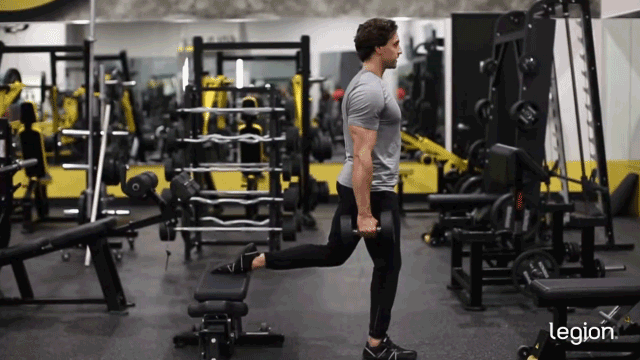
Few dumbbell hamstring exercises are as effective as the Bulgarian split squat. Because it’s a unilateral exercise, it’s also useful for finding and fixing muscle or strength imbalances.
- While holding a dumbbell in each hand, stand about 2-to-3 feet in front of a bench with your back to the bench.
- With your right foot planted, place the top of your left foot on the bench behind you.
- Lower your butt toward the floor by bending your right knee until your right thigh is roughly parallel with the floor.
- Stand up and return to the starting position.
6. Hip Thrust
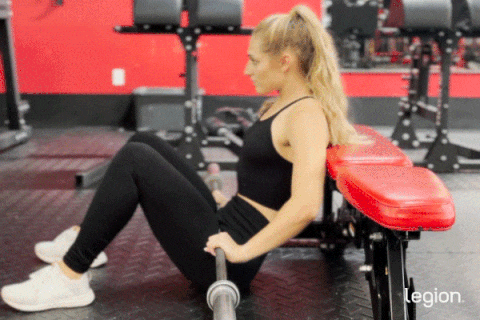
The hip thrust is another excellent barbell hamstring exercise that forces your hamstrings to work hard throughout the entire range of motion, which is a unique benefit of the exercise
- Sit on the ground with your shoulders resting against a bench that’s perpendicular to your body.
- Roll a barbell over your thighs so it sits in your hip crease.
- Plant your feet on the floor about shoulder-width apart and 12-to-18 inches from your butt so your knees are bent to about 90 degrees.
- Push the bar upward with your hips by pressing through your heels until your upper body and thighs are parallel to the ground and your shins are vertical.
- Reverse the movement and return to the starting position.
7. Leg Curl
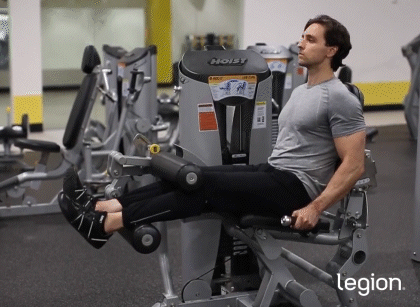
Unlike most hamstring exercises, the seated leg curl trains your hamstrings through a full range of motion and in a stretched position, making it highly effective for gaining hamstring size and strength.
- Sit on the leg curl machine with the back of your knees a couple of inches off the pad supporting your thighs and adjust the heel pad so it’s across your Achilles tendons.
- Press your heels toward your butt until your shins are roughly perpendicular to your thighs (or closer)
- Raise your heels and return to the starting position.
8. Nordic Leg Curl
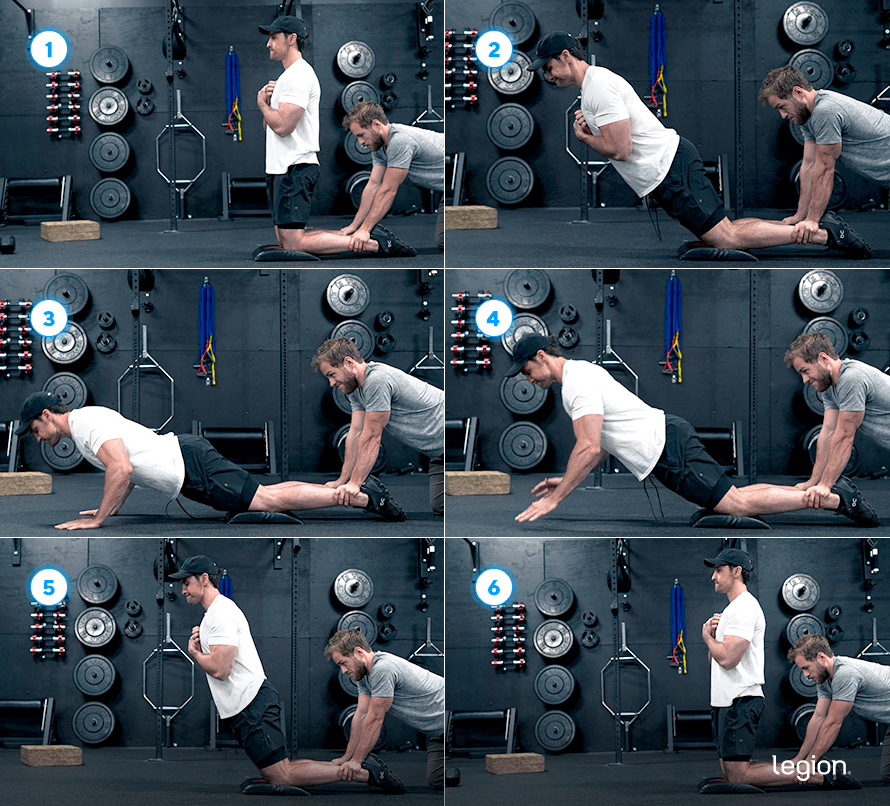
Most guides that explain how to strengthen your hamstrings sleep on the Nordic leg curl, but this is a mistake; research shows it’s an outstanding bodyweight hamstring exercise that may reduce your risk of hamstring injury. Because it requires no equipment, it’s also ideal for anyone looking to do home hamstring workouts.
- Kneel on a yoga mat or cushioned pad facing away from your training partner, and have your partner hold your legs around your ankles and pin your feet to the floor.
- Place your hands in front of your chest, then while squeezing your glutes, hamstrings, and abs and maintaining a straight line between your head and knees, lower your chest toward the floor by leaning forward, using your hamstrings to ensure the movement is slow and controlled.
- As you near the floor, put your hands out to catch your body and prevent your chest from hitting the floor.
- While maintaining the straight line between your head and knees, pull your body back to the starting position using your hamstrings. (If necessary, push off the floor with your hands to initiate the curl.)
The Best Hamstring Workout Routine for Mass
Below is a hamstring-focused leg day designed to add mass to the back of your thighs:
- Deadlift: 3 sets of 4-to-6 reps with 2-to-4 min rest
- Bulgarian Split Squat: 3 sets of 4-to-6 reps with 2-to-4 min rest
- Hip Thrust: 3 sets of 6-to-8 reps with 2-to-4 min rest
- Leg Curl: 3 sets of 6-to-8 reps with 2-to-4 min rest
Remember, this is a hamstring-focused leg day workout, not a balanced leg routine. Thus, you shouldn’t use it as your only lower-body workout each week for an extended period.
Instead, do it as one of your lower-body workouts in an upper lower split (and do a quad-focused workout on your other lower-body day). Or, think of it as a “specialized” routine that you follow for 8-to-10 weeks before switching to a more well-rounded leg workout like this:
Leg Day Workout Routine for Hypertrophy & Building Mass
3 Tips to Optimize Your Hamstring Workout Routines
1. End every set 1-to-3 reps shy of muscle failure.
As I explain in my fitness books for men and women, to maximize your results, you must take most sets of hamstring exercises to within a rep or two of failure.
Ask yourself at the end of each set, “If I had to, how many more reps could I have gotten with good form?” If the answer is more than two, increase the weight or reps to make your next set more challenging.
2. Once you hit the top of your rep range for a set, move up in weight.
If your hamstring workout routine calls for 4-to-6 reps of the deadlift and you get 6 reps for a set, add 10 pounds to your next set.
If you manage 3 or fewer reps with the new weight, reduce the weight by 5 pounds to ensure you stay in the 4-to-6 rep range.
Follow this pattern of trying to add reps or weight to every exercise in every workout.
3. Take the right supplements.
These supplements can help you optimize your performance and gains while following a hamstring workout routine:
- Protein powder: Protein powder, such as whey or casein, provides your body with the nutrients needed to build muscle tissue and recover from workouts.
- Creatine: Creatine supplements, such as creatine monohydrate powder and gummies, boost muscle and strength gain, improve anaerobic endurance, and reduce muscle damage and soreness from your workouts.
- Pre-workout: A high-quality pre-workout enhances energy, mood, and focus, increases strength and endurance, and reduces fatigue.
(If you’d like even more specific advice about which supplements you should take to reach your health and fitness goals, take the Legion Supplement Finder Quiz, and in less than a minute, you’ll know exactly what supplements are right for you.)
Hamstring Exercises and Workouts FAQs
1. What is the best exercise for your hamstrings?
There’s no such thing as the “best” hamstring exercise since the effectiveness of a hamstring exercise can vary based on individual goals and fitness level.
That said, most people regard the deadlift as the best hamstring exercise because it allows you to lift heavy weights safely and progress regularly, making it ideal for building mass and strength.
2. How can I target my hamstrings at home?
To do home hamstring workouts, focus on bodyweight hamstring exercises, such as the Nordic hamstring curl and glute bridge.
Dumbbell hamstring exercises, such as the single-leg Romanian deadlift and Bulgarian split squat, are also viable options if you have access to basic equipment.
3. How many exercises are needed for hamstrings?
To ensure balanced development, do 3-to-6 hamstring exercises each week. If you’re new to weightlifting or not looking to focus on hamstring development, doing 3 exercises is usually sufficient. For those looking to prioritize hamstring growth, doing 4-to-6 hamstring exercises will yield better results.
Scientific References +
- Schellenberg, Florian, et al. “Towards Evidence Based Strength Training: A Comparison of Muscle Forces during Deadlifts, Goodmornings and Split Squats.” BMC Sports Science, Medicine and Rehabilitation, vol. 9, no. 1, 17 July 2017, https://doi.org/10.1186/s13102-017-0077-x.
- Ebben, William P. “Hamstring Activation during Lower Body Resistance Training Exercises.” International Journal of Sports Physiology and Performance, vol. 4, no. 1, Mar. 2009, pp. 84–96, https://doi.org/10.1123/ijspp.4.1.84.
- Jones, Margaret T, et al. “Effects of Unilateral and Bilateral Lower-Body Heavy Resistance Exercise on Muscle Activity and Testosterone Responses.” Journal of Strength and Conditioning Research, vol. 26, no. 4, Apr. 2012, pp. 1094–1100, https://doi.org/10.1519/jsc.0b013e318248ab3b.
- Contreras, Bret, et al. “Barbell Hip Thrust.” Strength and Conditioning Journal, vol. 33, no. 5, Oct. 2011, pp. 58–61, https://doi.org/10.1519/ssc.0b013e31822fa09d.
- Maeo, Sumiaki, et al. “Greater Hamstrings Muscle Hypertrophy but Similar Damage Protection after Training at Long versus Short Muscle Lengths.” Medicine & Science in Sports & Exercise, vol. 53, no. 4, 2 Oct. 2020, pp. 825–837, https://doi.org/10.1249/mss.0000000000002523.
- Yanagisawa, Osamu, and Atsuki Fukutani. “Muscle Recruitment Pattern of the Hamstring Muscles in Hip Extension and Knee Flexion Exercises.” Journal of Human Kinetics, vol. 72, no. 1, 31 Mar. 2020, pp. 51–59, https://doi.org/10.2478/hukin-2019-0124.
- Cuthbert, Matthew, et al. “The Effect of Nordic Hamstring Exercise Intervention Volume on Eccentric Strength and Muscle Architecture Adaptations: A Systematic Review and Meta-Analyses.” Sports Medicine, vol. 50, no. 1, 9 Sept. 2019, link.springer.com/article/10.1007/s40279-019-01178-7, https://doi.org/10.1007/s40279-019-01178-7.
- Stokes, Tanner, et al. “Recent Perspectives Regarding the Role of Dietary Protein for the Promotion of Muscle Hypertrophy with Resistance Exercise Training.” Nutrients, vol. 10, no. 2, 7 Feb. 2018, p. 180, www.mdpi.com/2072-6643/10/2/180/pdf, https://doi.org/10.3390/nu10020180.
- Eckerson, Joan M., et al. “Effect of Creatine Phosphate Supplementation on Anaerobic Working Capacity and Body Weight after Two and Six Days of Loading in Men and Women.” The Journal of Strength and Conditioning Research, vol. 19, no. 4, 2005, p. 756, https://doi.org/10.1519/r-16924.1.
- Bassit, Reinaldo Abunasser, et al. “Effect of Short-Term Creatine Supplementation on Markers of Skeletal Muscle Damage after Strenuous Contractile Activity.” European Journal of Applied Physiology, vol. 108, no. 5, 3 Dec. 2009, pp. 945–955, https://doi.org/10.1007/s00421-009-1305-1.
